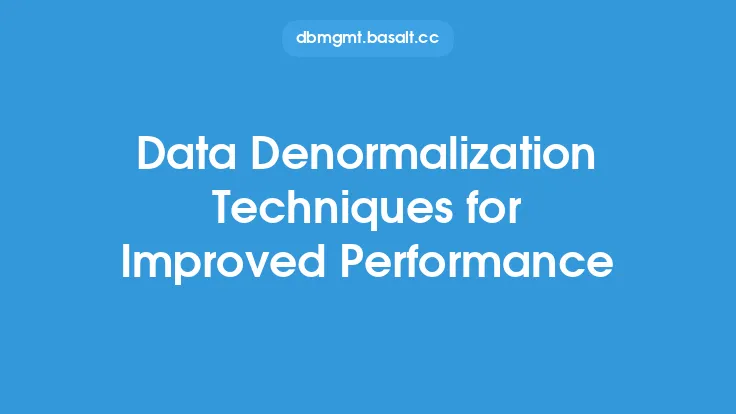Data analysis is a crucial aspect of any organization, as it helps in making informed decisions, identifying trends, and optimizing processes. However, complex data sets can be challenging to analyze, and this is where data disaggregation techniques come into play. Data disaggregation is the process of breaking down complex data sets into smaller, more manageable components, allowing for more detailed and accurate analysis. In this article, we will delve into the various data disaggregation techniques that can be used to improve data analysis.
Introduction to Data Disaggregation Techniques
Data disaggregation techniques are used to decompose complex data sets into smaller, more granular components. This process involves identifying the individual elements that make up the complex data set and analyzing each component separately. There are several data disaggregation techniques that can be used, including hierarchical decomposition, factor analysis, and clustering analysis. Each technique has its own strengths and weaknesses, and the choice of technique depends on the nature of the data and the goals of the analysis.
Hierarchical Decomposition
Hierarchical decomposition is a data disaggregation technique that involves breaking down complex data sets into a hierarchical structure. This technique is useful for analyzing data that has a natural hierarchical structure, such as organizational data or geographical data. The hierarchical structure is created by identifying the individual elements that make up the complex data set and grouping them into categories. For example, a company's sales data can be broken down into regions, countries, states, and cities, allowing for more detailed analysis of sales trends and patterns.
Factor Analysis
Factor analysis is a statistical technique that is used to identify the underlying factors that contribute to the variance in a complex data set. This technique is useful for analyzing data that has a large number of variables, as it helps to reduce the dimensionality of the data and identify the most important factors. Factor analysis involves calculating the correlation between each pair of variables and using this information to identify the underlying factors. For example, a company's customer data can be analyzed using factor analysis to identify the underlying factors that contribute to customer satisfaction, such as product quality, price, and customer service.
Clustering Analysis
Clustering analysis is a data disaggregation technique that involves grouping similar data points into clusters. This technique is useful for analyzing data that has a large number of variables and identifying patterns and trends. Clustering analysis involves calculating the similarity between each pair of data points and using this information to group them into clusters. For example, a company's customer data can be analyzed using clustering analysis to identify customer segments with similar characteristics, such as demographics, behavior, and preferences.
Data Disaggregation Using Regression Analysis
Regression analysis is a statistical technique that is used to model the relationship between a dependent variable and one or more independent variables. Data disaggregation using regression analysis involves breaking down the complex data set into smaller components and analyzing the relationship between each component and the dependent variable. This technique is useful for analyzing data that has a large number of variables and identifying the most important factors that contribute to the variance in the dependent variable. For example, a company's sales data can be analyzed using regression analysis to identify the factors that contribute to sales, such as price, advertising, and seasonality.
Data Disaggregation Using Time Series Analysis
Time series analysis is a statistical technique that is used to analyze data that varies over time. Data disaggregation using time series analysis involves breaking down the complex data set into smaller components, such as trend, seasonality, and residuals, and analyzing each component separately. This technique is useful for analyzing data that has a strong temporal component, such as sales data, stock prices, and weather data. For example, a company's sales data can be analyzed using time series analysis to identify the trend, seasonality, and residuals, and make predictions about future sales.
Data Disaggregation Using Text Analysis
Text analysis is a technique that is used to analyze unstructured data, such as text documents, emails, and social media posts. Data disaggregation using text analysis involves breaking down the complex data set into smaller components, such as keywords, phrases, and sentiment, and analyzing each component separately. This technique is useful for analyzing data that has a large amount of unstructured text, such as customer feedback, product reviews, and social media posts. For example, a company's customer feedback data can be analyzed using text analysis to identify the keywords, phrases, and sentiment, and make improvements to products and services.
Conclusion
Data disaggregation techniques are essential for improving data analysis, as they allow for more detailed and accurate analysis of complex data sets. The various techniques, such as hierarchical decomposition, factor analysis, clustering analysis, regression analysis, time series analysis, and text analysis, can be used to break down complex data sets into smaller, more manageable components, and analyze each component separately. By using these techniques, organizations can gain a deeper understanding of their data, identify trends and patterns, and make informed decisions. As data continues to play an increasingly important role in business and decision-making, the use of data disaggregation techniques will become even more critical for organizations that want to stay ahead of the curve.





